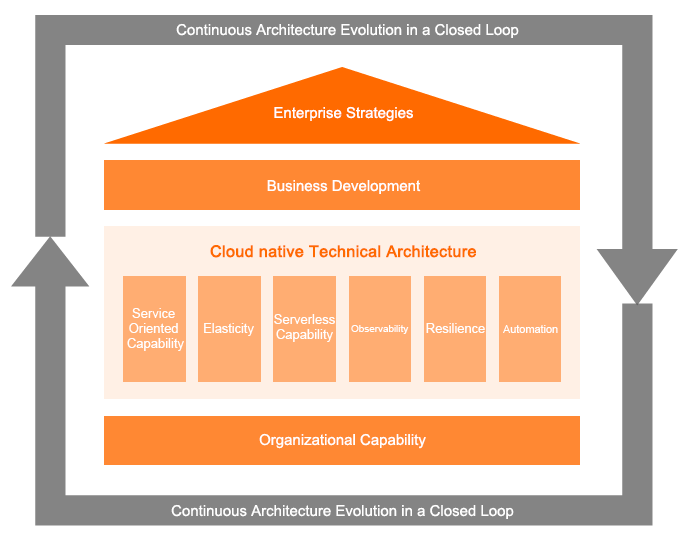To learn more about designing and developing the right cloud-native architecture for your business, download The Cloud-Native Architecture White Paper today.
A cloud-native architecture is the next evolution of the cloud. It provides a plan or design for your cloud-based applications and services, focusing on how to optimize your system architectures for the capabilities of the cloud to realize seamless agility, elasticity, fault tolerance and portability.
To achieve this, your cloud-based architecture will consist of many different components, including containers, microservices and service meshes. With a cloud-native architecture, you can add, change or replace these components with ease – and without affecting the other components in your infrastructure. But how do you design a cloud-native architecture? Where should you start?
Appropriately, the design process for a cloud-native architecture also breaks the project down into manageable chunks. Our Alibaba Cloud Native Architecture (ACNA) is one example, using a "4 + 1" architecture design process. The number 4 indicates the key perspectives of the architecture design, including enterprise strategies, business development, organizational capabilities, and cloud-native technologies. The number 1 indicates the closed loop of continuous cloud-native architecture evolution.
ACNA is based on a DevOps with the cloud methodology, accelerating your software development and delivery. It is available at varying levels of maturity, which are ranked across six architectural dimensions.

A cloud-native architecture uses microservices, which are an architectural approach to building applications in a distributed and loosely coupled fashion. This is a form of service-oriented architecture (SOA), which separates the business into distinct modules, each of which has different iteration cycles and integrates and orchestrates modules by using standardized API operations.
Your services are also integrated, based on events, to further reduce dependencies between different services. By using different methods to assess your service capabilities, this provides a higher level of SLA-defined services. Alibaba Cloud excels in this space, being the first cloud providers to offer 99.975% SLA for a single instance and network.
Elasticity is a defining feature of the cloud, where a cloud-based infrastructure can dynamically scale your resources up and down. But just because an app exists on the cloud, does not guarantee its elasticity – this is where a cloud-native architecture can help, automatically scaling your applications based on business peaks and resource loads to achieve ultimate elasticity. Using a cloud-native architecture, the total transaction amount during the Double 11 Shopping Festival in 2020, for example, reached 498.2 billion RMB.
Serverless Computing is an event-driven cloud-native development model that allows developers to build and run applications without managing any servers. It is sometimes referred to as Function-as-a-Service (FaaS) or Backend-as-a-Service (BaaS). Serverless does not mean "without a server." Instead, the details of your infrastructure orchestration are managed by a serverless platform provider and are hidden from your developers and end users.
As a result, developers can focus on the design and execute applications in a stateless manner and deploy stateful applications in cloud services. These stateless containers are event-driven, created when an event occurs and triggers a specific action. Your applications are bundled as one or more functions, uploaded to your platform and then executed, scaled, and billed in response to the exact demand needed at the moment.
Every IT infrastructure must be continuously managed, to fix any hardware and software errors before they adversely affect your business. This requires observability to create a robust and comprehensive quality of service (QoS) policy. Using a cloud-native architecture, there are many methods to keep your system under observation, including automation to free up your time and resources.
At Alibaba Cloud, these methods include our Log Analysis function for real-time log search and analysis, Tracing Analysis to identify performance bottlenecks and Application Real-time Management Service (ARMS) to comprehensively monitor your applications.
A cloud-native architecture supports high availability, disaster recovery, and asynchronization, using a vast range of technologies, including circuit breaking, throttling, degradation, automatic retry, and backpressure to achieve this. If you opt for an ACNA-4 maturity model, for example, your architecture uses serverless services and services meshes, allowing you to switchover in seconds.
A cloud-native architecture can expedite your development, testing, and O&M efforts, with several automation options available to streamline your efforts further. Using an Open Application Model (OAM), for example, you can standardize your software delivery, and an IaC or GitOps technology can also automate your Continuous Integration (CI) and Continuous Deployment (CD) pipeline and O&M.
While a cloud-native architecture is not scored based on security, it provides a robust set of security solutions for your business. In addition to using cloud services to enhance business security, it uses the software development life cycle (SDLC) to develop applications that follow the ISO 27001, Payment Card Industry Data Security Standard (PCI DSS), and Baseline for Classified Protection of Cybersecurity standards.
A cloud-native architecture is the next evolution in cloud computing, providing a vast range of value-added capabilities to your business. Alibaba Cloud can help you set-up, deploy and manage a cloud-native architecture to innovate and optimize your business. To find out more download The Cloud-Native Architecture White Paper today.
Alibaba Cloud Recognized as a Top Hosted Serverless Platform in CNCF Cloud Native Survey China 2019

2,593 posts | 790 followers
FollowAlibaba Cloud Native - October 27, 2021
Alibaba Developer - December 16, 2021
Alibaba Cloud Native Community - December 16, 2021
Hologres - June 30, 2021
Alibaba Cloud Community - October 16, 2025
Alibaba Cloud Community - November 20, 2024

2,593 posts | 790 followers
Follow Container Service for Kubernetes
Container Service for Kubernetes
Alibaba Cloud Container Service for Kubernetes is a fully managed cloud container management service that supports native Kubernetes and integrates with other Alibaba Cloud products.
Learn More ACK One
ACK One
Provides a control plane to allow users to manage Kubernetes clusters that run based on different infrastructure resources
Learn More Microservices Engine (MSE)
Microservices Engine (MSE)
MSE provides a fully managed registration and configuration center, and gateway and microservices governance capabilities.
Learn More Cloud-Native Applications Management Solution
Cloud-Native Applications Management Solution
Accelerate and secure the development, deployment, and management of containerized applications cost-effectively.
Learn MoreMore Posts by Alibaba Clouder